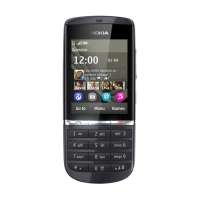
Do you have a question about the Nokia 300 and is the answer not in the manual?
| 2G bands | GSM 850 / 900 / 1800 / 1900 |
|---|---|
| SIM | Mini-SIM |
| Type | TFT resistive touchscreen, 256K colors |
| Resolution | 240 x 320 pixels, 4:3 ratio (~167 ppi density) |
| Call records | Yes |
| Loudspeaker | Yes |
| 3.5mm jack | Yes |
| WLAN | No |
| Messaging | SMS, MMS, Email, IM |
| Browser | WAP 2.0/xHTML, HTML |
| Java | Yes, MIDP 2.1 |
| Battery | Removable Li-Ion 1110 mAh battery (BL-4U) |
| Network | GSM |
| Weight | 85 g |
| Size | 2.4 inches, 17.8 cm2 |
| Memory Card slot | microSD, up to 32 GB |
| Phonebook | Yes |
| Alert types | Vibration, MP3 ringtones |
| Bluetooth | 2.1 |
| Radio | Stereo FM radio, RDS |
| USB | microUSB 2.0 |
| Games | Yes |
| Stand-by | Up to 600 h |
| Colors | White, Blue |
| OS | Series 40 |
Identifies the main physical components and buttons of the Nokia 300 phone.
Step-by-step guide on how to insert the SIM card and battery into the phone.
Instructions for inserting a memory card into the Nokia 300.
Guide on how to charge the phone's battery using a wall outlet or USB.
Steps to power on the Nokia 300, including initial date, time, and time zone setup.
Basic call management: dialing, answering, and rejecting incoming calls.
Adding new contacts and modifying their details.
Composing and sending text or voice messages.
Using the phone's camera to take pictures and record video clips.
Accessing websites and clearing browsing data.
Setting security codes for the phone and memory card.
Troubleshooting, software updates, and restoring settings.
General safety, restricted areas, road safety, and device care.
Device interaction with medical devices and operating environment.
Making emergency calls and protecting the device from harmful content.